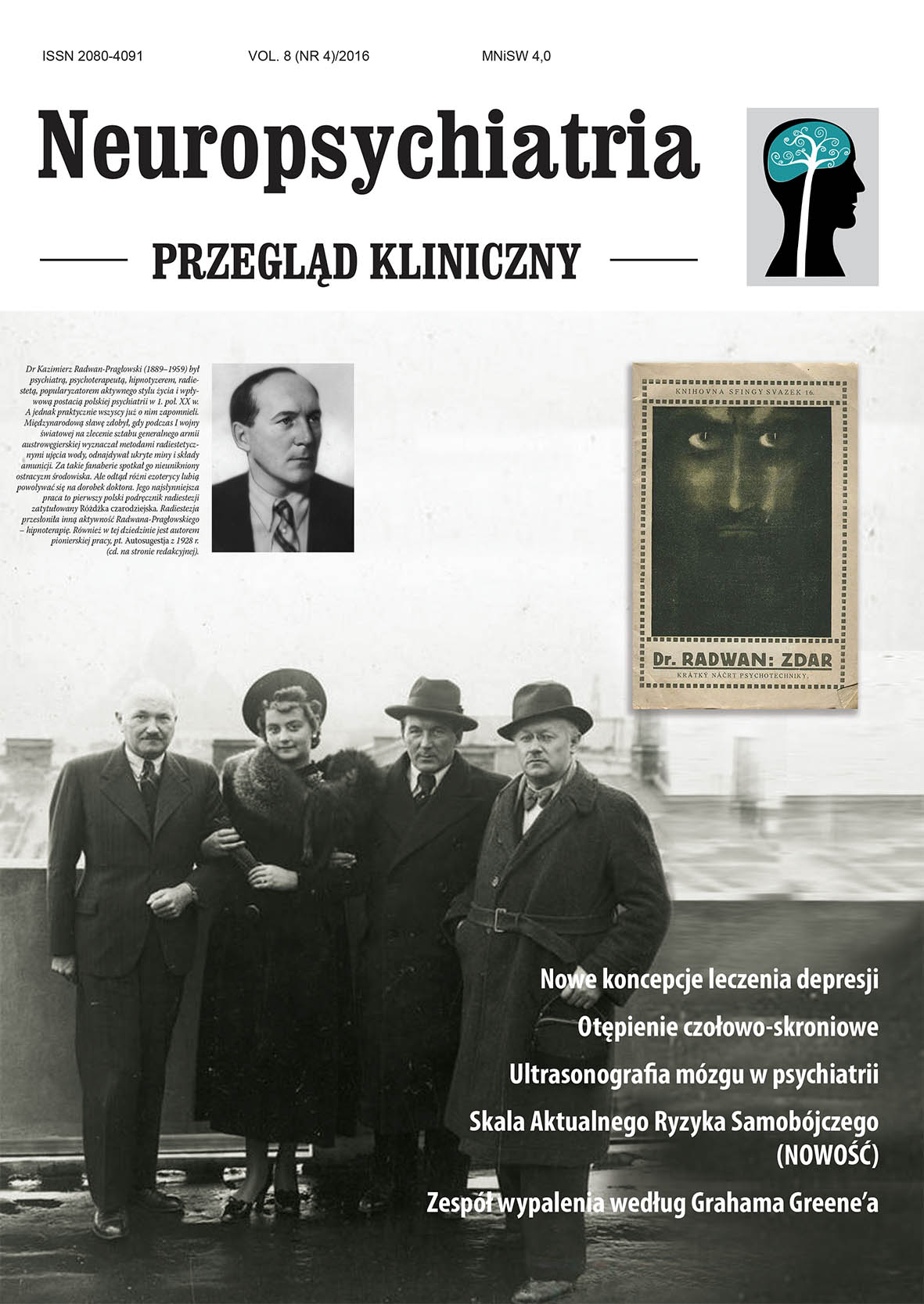The use of transcranial ultrasonography in diagnosis and treatment efficiency control of depression Review article
Main Article Content
Abstract
The very first use of transcranial ultrasonography (TCS) for diagnosing depression was conducted in 1994. Safety and very low cost of the method made it a very promising. Besides all advantages, the consensus about its administration in every day practice has not been established yet. We reviewed the articles presenting TCS in depressive patients. The echogenity change of the raphe nuclei in active (treatment) groups ranged from 36.7% up to 95%. Taking into consideration the results from control groups (5–76.47%), the statistical variation is too large to conclude. The concept needs further studies.
Article Details

This work is licensed under a Creative Commons Attribution-NonCommercial-NoDerivatives 4.0 International License.
Copyright: © Medical Education sp. z o.o. License allowing third parties to copy and redistribute the material in any medium or format and to remix, transform, and build upon the material, provided the original work is properly cited and states its license.
Address reprint requests to: Medical Education, Marcin Kuźma (marcin.kuzma@mededu.pl)
References
2. Coppen A. The biochemistry of affective disorders. Br J Psychiatry 1967; 113: 1237-1264.
3. Curzon G, Green AR. Effects of immobilization on rat liver tryptophan pyrrolase and brain 5-hydroxytryptamine metabolism. Br J Pharmac 1969; 37: 689-697.
4. Lapin IP, Oxenkrug GF. Intensification of the central serotoninergic processes as a possible determinant of the thymoleptic effect. Lancet 1969; 1(7586): 132-136.
5. Becker G, Becker T, Struck M. Reduced echogenicity of brainstem raphe specific to unipolar depression: A transcranial color- coded real time sonography study. Biol Psychiatry 1995; 38: 180-184.
6. Zhang YC, Hu H, Luo WF et al. Alteration of brainstem raphe measured by transcranial sonography in patients with or without Parkinson’s disease. Neurol Sci 2016; 37: 45-50.
7. Krogias C, Strassburger K, Eyding J et al. Depression in patients with Huntington disease correlates with alterations of the brain stem raphe depicted by transcranial sonography. J Psychiatry Neurosci 2011; 36(3): 187-194.
8. Ghourchian S, Zamani B, Poorkosary K et al. Raphe nuclei echogenicity changes in major depression. Med J Islam Repub Iran 2014; 28(9): 1-5.
9. Becker T, Becker G, Seufert J et al. Parkinson’s disease and depression: evidence for an alteration of the basal limbic system detected by transcranial sonography. J Neurol Neurosurg Psychiatry 1997; 63: 590-596.
10. Walter U, Prudente-Morrissey L, Herpetz SC et al. Relationship of brainstem raphe echogenicity and clinical findings in depressive states. Psychiatry Res 2007; 155: 67-73.
11. Budisic M, Karlovic D, Trkanjec Z et al. Brainstem raphe lesion in patients with major depression disorder and in patients with sucidial ideation recorded on transcranial sonography. Eur Arch Pyschiatry Clin Neurosci 2010; 260: 203-208.
12. van Duijn E, Kingma EM, van der Mast RC. Psychopathology in verified Huntington‘s disease gene carriers. J Neuropsychiatry Clin Neurosci 2007; 19(4): 441-448.
13. Bouwmans AEP, Weber WEJ, Leentjens AFG, Mess WH. Transcranial sonography findings related to depression in parkinsonian disorders: cross-sectional study in 126 patients. Peer J 4: e2037. https://doi.org/10.7717/peerj.2037.
14. Hoeppner J, Prudente-Morrissey L, Herpertz SC et al. Substantia nigra hyperechogenicity in depressive subcjects relates to motor asymmetry and impaired word fluency. Eur Arch Psychiatry Clin Neurosci 2009; 259: 92-97.
15. Steele JD, Bastin ME, Wardlaw JM, Ebmeier KP. Possible structural abnormality of the brainstem in unipolar depressive illness: a transcranial ultrasound and diffusion tensor magnetic resonance study. J Neurol Neurosurg Psychiatry 2005; 76(11): 1510-1515.

